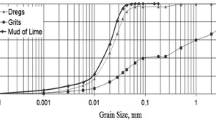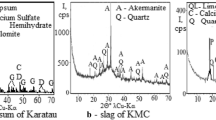Abstract
The main goals of this study were the development of new composites of construction materials from three types of construction industry wastes: construction and demolition debris, plaster waste, and lime production waste; determination of the physical-chemical processes of new composites structure formation. The study was using the methods of X-ray powder diffraction, scanning electron microscopy, energy dispersive spectroscopy, and laser micro-mass analyses. The strength of the test samples on the 180th day reached 16.7 MPa, the coefficient of linear expansion during hydration and hardening of the test samples till 1.81%, the water absorption 14.9%, and the apparent density till 1.95 g/cm3. The processes of structure formation showed hardening of the materials due to alkaline dissolving of the surfaces of solid particles, followed by chemical interaction of these alkaline solutions, with the synthesis of predominantly amorphous new sol-gel formations of the CSH group and of carbonates; over time, these new gel formations are transformed into a stony state.









Similar content being viewed by others
References
European Commission, EU Construction and Demolition Waste Protocol and Guidelines (2018) ec.europa.eu/growth/content/eu-construction-anddemolition-waste-protocol-0_en Accessed July 17, 2019
Rodrigues F et al (2013) Physical–chemical and mineralogical characterization of fine aggregates from construction and demolition waste recycling plants. J Clean Prod 52:438–445. https://doi.org/10.1016/j.jclepro
Pedroza MG et al (2020) The use of coal ash and plaster waste to improve grounding system. J Clean Prod 264:121504. https://doi.org/10.1016/j.jclepro.2020.121504
Geraldo RH et al (2017) Gypsum plaster waste recycling: a potential environmental and industrial solution. J Clean Prod 164:288–300. https://doi.org/10.1016/j.jclepro.2017.06.188
Nascimento AS et al (2020) Production of plaster mortar with incorporation of granite cutting wastes. J Clean Prod 265:121808. https://doi.org/10.1016/j.jclepro.2020.121808
Contreras M et al (2016) Recycling of construction and demolition waste for producing new construction material (Brazil case-study). Constr Build Mater 123:594–600. https://doi.org/10.1016/j.conbuildmat.2016.07.044
Xuan D et al (2018) Management and sustainable utilization of processing wastes from ready-mixed concrete plants in construction: a review. Resour Conserv Recycl 136:238–247. https://doi.org/10.1016/j.resconrec.2018.04.007
Mymrin V et al (2019) Sustainable stabilization/solidification of Kazakhstan’s natural loam by hazardous ground cooled ferrous slag activated by lime production waste to produce efficient road base material. J Clean Prod 231:1428–1436. https://doi.org/10.1016/j.jclepro.2019.05.250
Arulrajah A et al (2012) Geotechnical characteristics of recycled crushed brick blends for pavement sub-base applications. J Can Geotech 49:796–811. https://doi.org/10.1139/t2012-041
Acchar W et al (2009) Properties of clay-based ceramics added with construction and demolition waste, In: EPD Congress - 138th Annual Meeting & Exhibition, TMS 2009, San Francisco, USA, 907-910
Bassani M et al (2019) Alkali-activation of recycled construction and demolition waste aggregate with no added binder. Construct Build Mater 205:398–413. https://doi.org/10.1016/j.conbuildmat.2019.02.031
Ram VG, Kishore KC, Kalidindi SN (2020) Environmental benefits of construction and demolition debris recycling: evidence from an Indian case study using life cycle assessment. J Clean Prod 255:120258. https://doi.org/10.1016/j.jclepro.2020.120258
Blaisi NI (2019) Construction and demolition waste management in Saudi Arabia: current practice and roadmap for sustainable management. J Clean Prod 221:167–175. https://doi.org/10.1016/j.jclepro.2019.02.264
Llatas C et al (2021) A life cycle assessment-based model for assessing prevention versus non-prevention of construction waste in buildings. Waste Manag 126:608–622. https://doi.org/10.1016/j.wasman.2021.03.047
Mymrin V. (2012) Industrial and municipal wastes utilization as economical and environment efficient raw materials. Available at: http://paginapessoal.utfpr.edu.br/mymrinev. Accessed 13 March 2012
Mymrin V et al (2017) Environmentally clean materials from hazardous red mud, ground cooled ferrous slag and lime production waste. J Mater Sci Waste Manag. https://doi.org/10.1016/j.jclepro.2017.05.109
Silva RV et al (2014) Properties and composition of recycled aggregates from construction and demolition waste suitable for concrete production. Construct Build Mater 65:201–217. https://doi.org/10.1016/j.conbuildmat.2014.04.117
Wang K et al (2019) Amendment of municipal sewage sludge with lime and mussel shell: effects on fate of organic matter and pharmaceutically active compounds. Waste Manag 85:272–282. https://doi.org/10.1016/j.wasman.2018.12.03
Karanac M et al (2018) The removal of Zn2+, Pb2+, and As(V) ions by lime activated fly ash and valorization of the exhausted adsorbent. Waste Manag 78:366–378. https://doi.org/10.1016/j.wasman.2018.05.052
Anastas PT, Warner JC (1998) Green chemistry: theory and practice. Oxford University Press, New York
GOST 9479-84 (1985) Natural stone blocks for facing products manufacture. Technical Standard, Ministry of Building Materials Industry, Moscow
NBR 9778 (2009) Hardened mortar and concrete - determination of water absorption, porosity index and density. Rio de Janeiro
NBR 6453 (2003) Quick lime for civil construction – requirements to quick lime of civil construction – Requirements
NBR 7170 (1983) Ceramic massive brick masonry. Rio de Janeiro
Acknowledgements
The authors express gratitude to the Laboratory of Mineralogy and Rocks (LAMIR) and the Laboratory of Environmental Technology (LTA), both at the Federal University of Paraná (UFPR), Curitiba, Brazil, for technical support of this study.
Availability of data and material
Not applicable.
Author information
Authors and Affiliations
Contributions
Vsévolod Mymrin - author of the idea, developer of the plan of the experiments, participant of all stages of research
Carlos E. Waltrick - performer of all laboratory experimental works and co-author of this manuscript
Kirill Alekseev - performer of all laboratory experimental works and co-author of this manuscript
Monica A. Avanci - performer of all laboratory experimental works and co-author of this manuscript
Paulo H.B. Rolim - performer of all laboratory experimental works and co-author of this manuscript
Claudia R. Bernardi - performer of all laboratory experimental works and co-author of this manuscript
Vitor Baldin - performer of all laboratory experimental works and co-author of this manuscript
Corresponding author
Ethics declarations
Ethics approval
Manuscript was prepared following the rules of good scientific practice.
Consent to participate
Not applicable.
Consent for publication
Not applicable.
Competing interests
The authors declare no competing interests.
Additional information
Publisher’s note
Springer Nature remains neutral with regard to jurisdictional claims in published maps and institutional affiliations.
Rights and permissions
About this article
Cite this article
Mymrin, V., Waltrick, C.E., Alekseev, K. et al. Manufacturing and properties of composite material from demolition debris, plaster waste, and lime production waste to decrease ecological problems of cities. Int J Adv Manuf Technol 115, 3441–3451 (2021). https://doi.org/10.1007/s00170-021-07306-w
Received:
Accepted:
Published:
Issue Date:
DOI: https://doi.org/10.1007/s00170-021-07306-w




